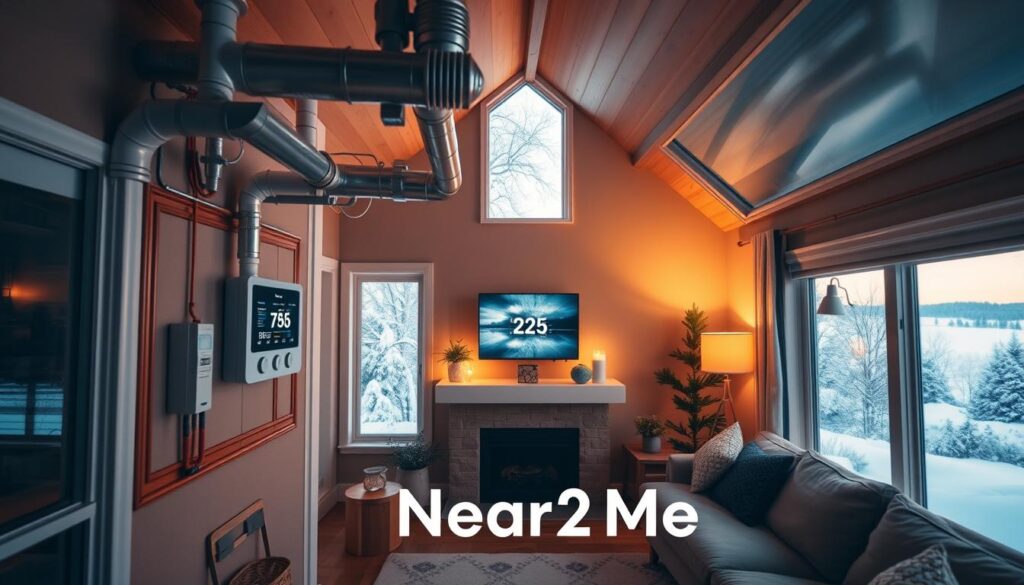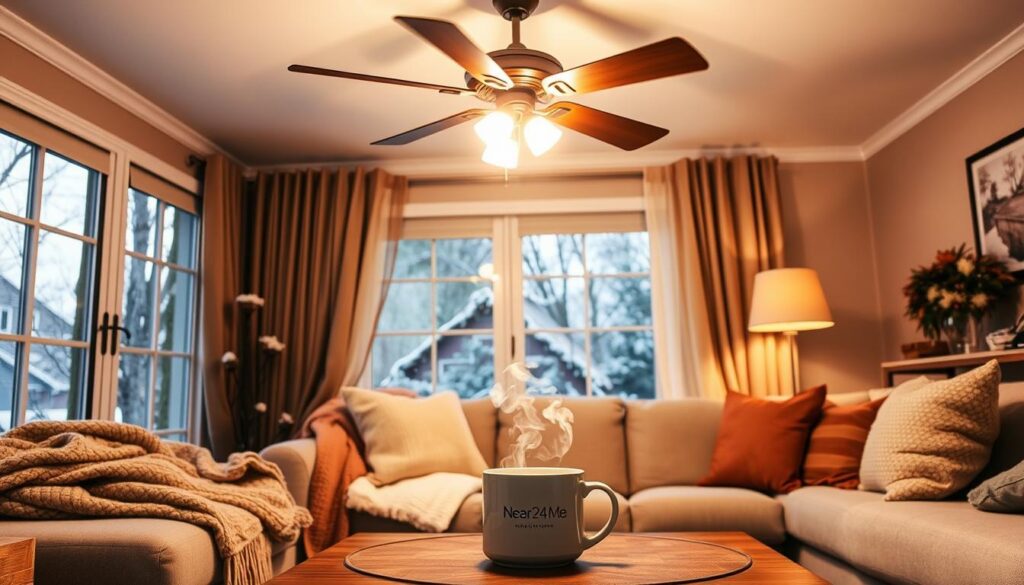Did you know that 31% of heat loss in homes happens through ceilings, walls, and floors that aren’t well-insulated1? This fact shows how important insulation is for a warm and energy-saving home in winter. As it gets colder and heating costs go up, keeping your home cozy and saving money on energy becomes a big challenge.
Windows and doors let out 21% of the heat, and air ducts let out 15%1. These numbers show why it’s key to fix heat loss in many parts of your home. By using smart strategies, you can avoid heating problems and cut down on energy use.
Switching to energy-saving heaters and sealing up windows and doors can save a lot on heating bills1. Also, setting your thermostat to 68°F (20°C) when you’re home and lowering it to 60–65°F (15–18°C) when you’re out can save up to 10% on heating and cooling costs each year1.
In this detailed guide, we’ll look at ways to keep your home warm in winter. We’ll cover everything from understanding heat loss to using smart tech and DIY insulation. We’ll show you how to keep your home cozy while keeping your heating costs down.
Table of Contents
Key Takeaways : “Plumbing Heating Near Me”
- Proper insulation is crucial for preventing heat loss and reducing energy costs
- Windows and doors are significant sources of heat escape
- Upgrading to energy-efficient heating systems can lead to substantial savings
- Simple thermostat adjustments can result in significant energy cost reductions
- Addressing multiple areas in your home is key to maintaining a warm environment
- Smart technologies and DIY upgrades can enhance your home’s energy efficiency
Understanding Heat Loss in Your Home
Heat loss in homes is a big deal for energy use and comfort. In Central New York, about 30% of heating energy is lost due to air leaks and bad insulation2. This loss affects your home’s energy use and can raise your utility bills.
Common Areas of Heat Escape
Heat escapes through different spots in your home. About 30% of air leaks are from ceilings, walls, and floors that aren’t well-insulated2. Leaky ducts also cause 15% of air loss2. Windows and doors are big trouble spots for insulation.

Identifying Drafts and Leaks
Drafts and leaks hurt your home’s warmth. A small gap under a door can lose as much heat as a big hole in a wall2. Improvements like plumbing and electrical work can also cause heat loss if not sealed right2.
The Impact of Poor Insulation
Poor insulation really affects your home’s energy use. The U-value shows how much heat is lost, with lower numbers being better3. For example, solid brick walls lose less heat than insulated walls3.
| Building Element | U-Value (W/m²K) |
|---|---|
| Solid Brick Walls | 2.1 |
| Insulated Cavity Walls | 0.55 |
| Glazed Wood Triple Doors | 2.6 |
| Solid Wood Doors | 3.0 |
Knowing about heat loss is key to making your home energy-smart and designing a good heating system3. Fixing these problems can make your home warmer and cut down on energy costs.
Sealing Windows and Doors for Better Insulation
Keeping your home warm in winter starts with proper insulation. Sealing windows and doors is a cost-effective way to reduce energy bills and improve comfort. Weatherstripping, door sweeps, window film, and caulking are key tools in this process.
Weatherstripping is a simple yet effective method for sealing gaps around doors and windows. It involves applying adhesive-backed foam tape or V-strips to create a tight seal. Door sweeps attach to the bottom of exterior doors, blocking drafts and keeping warm air inside. These quick fixes often pay for themselves within a year4.

Window film is another valuable tool. This clear plastic covering not only blocks drafts but also reduces solar heat gain and glare. For smaller cracks and gaps, silicone caulk works wonders. It’s particularly useful around window frames and baseboards where air might escape4.
Air leaks contribute to moisture problems, affecting both health and building durability. A comprehensive approach to sealing can significantly cut heating costs and improve indoor air quality45.
“Proper air sealing is the foundation of an energy-efficient home. It’s not just about comfort; it’s about creating a healthier living environment.”
Remember, while sealing is crucial, it doesn’t replace the need for proper insulation. Both work together to create an energy-efficient home. By tackling these simple DIY projects, you’ll notice a warmer home and lower energy bills this winter4.
Optimizing Your Existing Heating System
Keeping your home warm in winter starts with an efficient heating system. Focus on furnace maintenance and HVAC optimization. This way, your home stays cozy without costing too much.
Preventing Rapid Cycling
Rapid cycling happens when your furnace turns on and off too often. To stop this, adjust your thermostat’s cycle rate to 1-1.5 degrees. This small change can greatly improve your system’s efficiency and lifespan.
Regular Maintenance Tips
Regular furnace maintenance is key for energy-efficient heating. Replace filters monthly and keep vents clear for good airflow. Cleaning ducts and replacing filters stops dust buildup, boosting system performance6.
- Check and clean air filters every 1-3 months
- Keep vents and registers clear of furniture and debris
- Schedule annual professional inspections

Upgrading to Energy-Efficient Models
Think about upgrading to energy-efficient heating models for big savings. Look for furnaces with high AFUE (Annual Fuel Utilization Efficiency) ratings. A 90% AFUE rating means 90% of fuel turns to heat, with only 10% lost through exhaust7.
Professional maintenance plans can save you a lot of money. Regular tune-ups by experts can cut your annual heating costs by up to 25% and make your furnace last longer6. Skipping maintenance can void your warranty, so it’s smart to stay on top of regular checks.
By optimizing your heating system, you save money and help the environment. Well-maintained heating systems produce fewer greenhouse gases, making our planet more sustainable6. For reliable towing services in winter emergencies, keep a trusted provider’s contact handy.
Harnessing Natural Heat Sources
Passive solar heating is a smart way to warm your home. It uses sunlight to cut down on energy costs. This makes your home more comfortable.
Open curtains on south-facing windows when it’s sunny. This lets free heat into your home. Close them at night to keep the warmth in.
- Trim trees or shrubs that block sunlight from entering windows
- Install reflective window film to bounce more heat into rooms
- Use light-colored interior walls to reflect sunlight and distribute heat
Geothermal heat pumps are another natural heating option. They use the earth’s constant temperature, between 40°-70°F all year8. Though they cost more to install, they’re quieter and more efficient. You might save money in 5 to 10 years8.
These systems also produce less greenhouse gas and last longer than traditional HVAC9. Governments offer incentives and tax credits to help with the cost9.
Using passive solar heating and geothermal heat pumps together makes your home heating more sustainable and cost-effective.
Smart Use of Ceiling Fans in Winter
Ceiling fans are not just for cooling in summer. They also help circulate air in winter, making your home more comfortable and saving energy. Using ceiling fans wisely can cut down your winter energy use by up to 15%10.
Reversing Fan Direction
To get the most out of ceiling fans in winter, turn the blades to spin clockwise. This pushes warm air down from the ceiling1011. Most fans have a switch on the motor housing to change direction, making it easy to switch with the seasons10.

Optimal Fan Speed Settings
Use your fan on low speed for the best results. This gentle motion helps spread warm air trapped near the ceiling, making the room temperature even11. It also cuts down on moisture in kitchens, bathrooms, and laundry rooms, stopping mold and mildew10.
By improving how heat is distributed, ceiling fans help your furnace work less hard. This saves energy and can make your furnace last longer, giving you more time to save for a new one10. Especially in homes with high or vaulted ceilings, this makes the whole space cozy from floor to ceiling11.
Don’t forget to turn off fans when you leave the room to save energy. With these easy steps, you can make your home cozier and possibly lower your utility bills during winter11.
Installing and Using Programmable Thermostats
Programmable thermostats are a smart way to control your home’s temperature. They help save energy by adjusting the heat and cool when you’re not home or asleep12.
Setting up a programmable thermostat is easy, taking about 30 to 60 minutes if you’re handy12. But, make sure your HVAC system can work with it first. Some systems, like high-voltage or multistage, might not be compatible with all smart thermostats12.
Upgrading to a programmable thermostat can save you a lot of money. The average home spends over $2,000 a year on energy, with half going to heating and cooling. A programmable thermostat can cut that cost by about $200 a year13. Professional thermostat installation services can help set it up right for the best results.
Wi-Fi-enabled smart thermostats offer even more benefits. You can change settings from your phone, tablet, or laptop13. This makes it easy to control your energy use from anywhere.
For energy savings, keep your thermostat at 68°F when you’re home in winter. Lower it by 7-10 degrees when you’re asleep or out. This small change can save a lot of energy over time.
While you can install it yourself, getting a pro ensures it’s done safely and right. Experts can handle tricky wiring and help you get the most out of your thermostat14. With the right setup, a programmable thermostat can make your home more comfortable and save energy.
DIY Insulation Upgrades for Your Home
Improving your home insulation is a smart move to save energy and money. Let’s look at some DIY projects that can make your home warmer and cozier.
Window Treatments
Windows let a lot of heat escape. Adding thermal curtains or cellular blinds can help keep the air in. These simple changes can cut your energy bills by up to 20% each year15.
Pipe Insulation
Wrapping hot water pipes with foam sleeves is an easy DIY task. It stops heat loss and protects pipes from freezing. Also, add foam gaskets behind outlet and switch plates on exterior walls to block air leaks.
Attic Insulation Tips
The attic is crucial for insulation. Adding fiberglass batting can greatly improve your home’s energy efficiency. Most homeowners can do this project themselves. Also, replace old, leaky recessed light fixtures with airtight ones, especially in cathedral ceilings.
Weatherizing your home with these DIY insulation upgrades can cut your energy bills by up to 20% on average16. Even small changes like sealing air leaks or adding insulation can save a lot of money and make your home more comfortable.
| DIY Insulation Project | Difficulty Level | Potential Energy Savings |
|---|---|---|
| Window Treatments | Easy | 10-20% |
| Pipe Insulation | Easy | 5-10% |
| Attic Insulation | Moderate | 15-25% |
By doing these DIY insulation projects, you save money and make your home more comfortable. Remember, proper ventilation is key, so don’t forget to control humidity in damp areas like basements and crawl spaces.
Professional Insulation Solutions
Professional insulation solutions can make your home much cozier. Blown-in insulation and spray foam insulation are great for saving energy over time. They help keep your home warm, just like regular septic tank maintenance keeps your system running smoothly.
Blown-in insulation is easy to install and works well in tight spaces. Spray foam insulation, however, seals your home tight against heat and air. This makes it a top choice for better energy use17.
Getting a professional energy audit is a smart first step. It shows you where your home loses heat and helps you fix it. Companies like Alber Service Company have over 60 years of experience. They do free inspections and give you a clear idea of what you need18.
While insulation might cost more at first, it saves you money in the long run. Companies in the Dr. Energy Saver network use the best products and techniques. By choosing professional insulation, you’re making a wise choice for your comfort and savings18.








1 thought on “How to Keep Your Home Warm All Winter: Avoid Heating Breakdowns with These Tips”